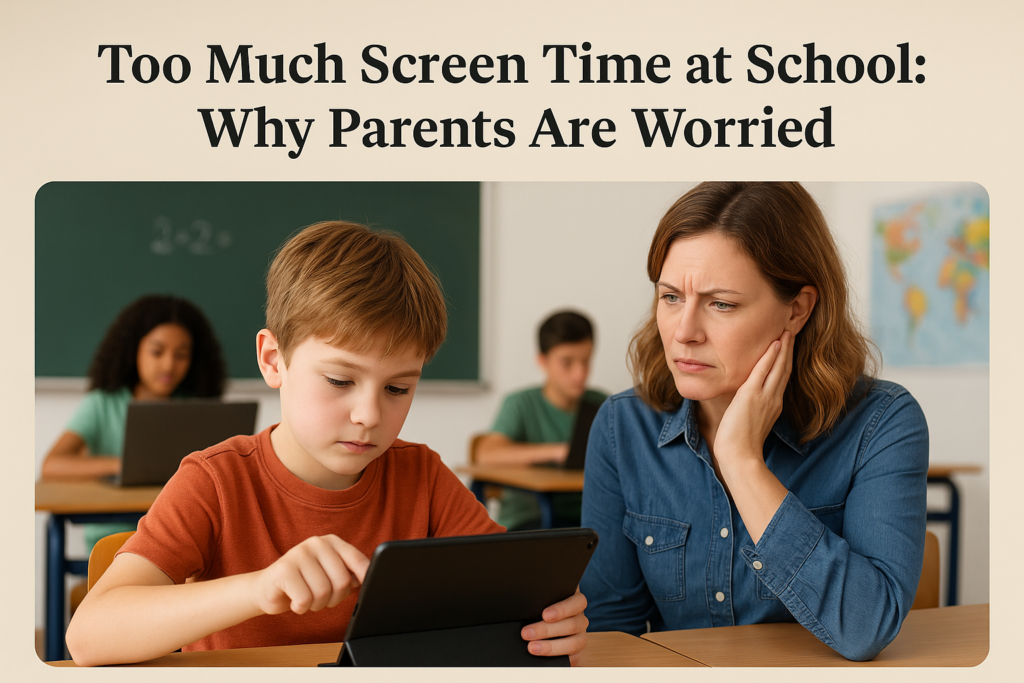
In the past decade, the role of technology in education has gone from supplemental to central. Laptops, tablets, and smartboards are now embedded into the daily routine of most American students, even at the elementary level. What started as a well-intentioned push for digital literacy has grown into an always-on, screen-saturated school environment, and many parents are sounding the alarm.
The concern is not just about eyestrain or tech addiction. Parents across the U.S. are increasingly worried about how constant screen exposure during school hours is affecting their children’s mental health, social development, and ability to focus. And they have good reason to be.
The Pandemic Effect
When COVID-19 hit, schools had no choice but to go fully remote. Screen time soared as Zoom classes replaced face-to-face learning and digital platforms became the primary mode of instruction. But now, even with most schools back in person, screens have not gone away. In fact, many districts doubled down on technology, using pandemic-era investments to integrate more digital tools into everyday classroom instruction.
Parents hoped that in-person school would mean less time staring at a screen. Instead, they have seen their kids toggling between Chromebooks and iPads for hours at a time, even during activities that used to be tactile and interactive, such as reading, drawing, or group projects.
The Toll on Focus and Mental Health
Research is beginning to catch up with what parents are observing firsthand. Studies have linked high screen time in kids with increased rates of anxiety, depression, sleep disruption, and attention issues. A 2023 report from Common Sense Media found that tweens, children ages eight to twelve, now spend an average of five and a half hours per day on screens, and much of that is school-related.
Teachers are also noticing that students struggle to focus, have shorter attention spans, and are less engaged in class. It is not just about distractions from games or social media. The constant switching between tabs, apps, and platforms trains young brains to seek novelty and multitask, habits that work against deep learning.
Loss of Hands-On Learning
Another big concern is what is being lost in the shift toward screens, which is real-world, hands-on experiences. Reading from a physical book builds different cognitive pathways than reading on a screen. Writing by hand improves memory retention and comprehension more than typing. Group activities in person foster social skills and empathy in ways that virtual interactions simply cannot replicate.
When screens mediate everything, even art, music, and science labs, kids miss out on the richness of sensory learning. That kind of engagement is critical for younger children especially, whose brains are still developing the foundational skills that digital tools often shortcut.
What Parents Are Demanding
Parents are not anti-technology. Most recognize the value of digital tools when used with intention. However, they want schools to strike a better balance and stop treating screens as a one-size-fits-all solution.
Across the country, parent groups are pushing for several changes. They want limits on screen time during school hours, especially for younger grades. They are asking for clear policies on device use, including screen breaks and off-screen learning activities. They also demand greater transparency about the software and platforms their children are required to use. Parents are calling for more investment in books, hands-on materials, and teacher training for non-digital instruction. Finally, they are urging schools to provide mental health support for students struggling with digital overload and attention fatigue.
In some districts, these concerns are gaining traction. A few schools are scaling back device use in kindergarten through third-grade classrooms, reintroducing cursive and handwriting instruction, and encouraging outdoor learning. Others are exploring technology-free Fridays or mandating analog alternatives to certain digital assignments.
The Role of Schools Moving Forward
The core issue is not technology itself. It is how we use it. Schools need to take a hard look at whether the tools they have adopted are actually improving learning outcomes or just adding convenience. Parents want to see a shift from the idea that more technology is better to the idea that smarter use of technology is better.
Digital literacy is important. But so is teaching kids how to think critically, engage with others, and be present in the real world. Schools must find a way to integrate technology without letting it dominate, and parents have a key role in holding them accountable.
Final Thought
Education is about preparing children for the world, not just the job market. That includes giving them the cognitive, emotional, and social tools to thrive. Sometimes, those tools look less like apps and more like pencils, books, and time spent with other humans. As schools push forward in the digital age, the challenge will be keeping that human element at the center of learning.
